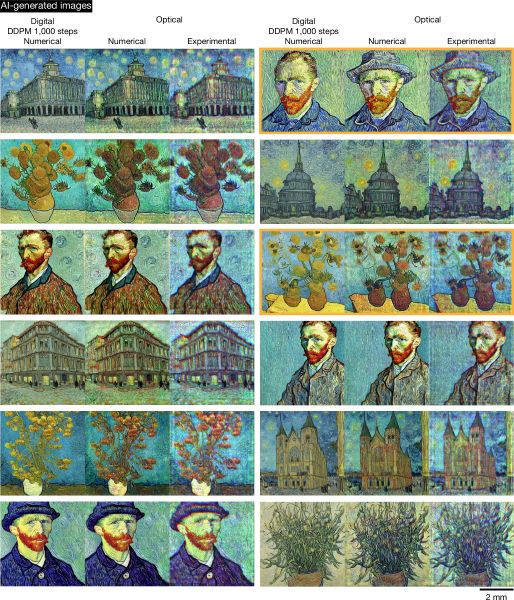Advance in optical computing may lead to ultrafast and secure image generators while using less energy.
Today’s popular chatbots and image generators have a severe downside for the environment.
These examples of generative artificial intelligence leave a substantial carbon footprint due to outsized energy demands. At the same time, the large amount of water used to cool the equipment behind generative AI depletes a finite resource that humans, other animals and plants need in order to survive. Additionally, running such models requires massive computational infrastructure, raising concerns about their long-term sustainability.
Now, researchers at the UCLA Samueli School of Engineering have unveiled a technology that may usher in a new era of sustainable generative AI. The team has created models capable of producing novel images using photonics — a form of computing based in light, in the same way traditional electronics are based in electrical signals. The study, published in Nature, presents a new paradigm that could dramatically reduce energy consumption while making possible scalable, high-performance content generation.
Instead of relying solely on digital computation, the researchers’ system performs the generative process optically — harnessing the speed of light and its inherent advantages for parallel processing to produce images in a single pass. By doing so, the team addresses one of generative AI’s greatest bottlenecks: balancing performance with efficiency.
“Our work shows that optics can be harnessed to perform generative AI tasks at scale,” said senior author Aydogan Ozcan, the Volgenau Professor of Engineering Innovation and professor of electrical and computer engineering and of bioengineering at UCLA Samueli. “By eliminating the need for heavy, iterative digital computation during image inference, optical generative models like ours open the door to snapshot, energy-efficient AI systems that could transform everyday technologies.”
The models developed by Ozcan and his colleagues train a digital encoder and an optical decoder together as one system. In contrast to the hundreds to thousands of iterative steps required by today’s generative AI models, this process generates images in a snapshot and requires no additional computation beyond the initial digital encoding and the successive optical decoding step. The new system also has flexibility; the same optical hardware can perform multiple tasks with simple updates to the encoder and decoder hardware.
To validate their approach, the researchers demonstrated both numerical and experimental results across diverse datasets. The models generated new images of handwritten digits, fashion items, butterflies and human faces. The optically generated outputs were shown to be statistically comparable to those from current advanced models, based on standard image quality metrics. The researchers also tested the system on artwork inspired by Vincent van Gogh using the optical generative model and compared its results against a teacher digital diffusion model — a powerful AI system that gradually refines random noise into detailed images through hundreds of iterative steps.
While the teacher model required 1,000 computational steps per image, the optical model generated each artwork in a single step per illumination wavelength during the experiment with visually comparable results. The optical model also used only a fraction of the energy per image required by the iterative digital diffusion process, demonstrating that light-based computation can produce high-quality artistic images efficiently.
Beyond efficiency and versatility, the optical generative models can provide built-in privacy and security. Multiple generated patterns or images can be simultaneously encoded using different wavelengths of light and only decoded with unique matched decoder surfaces. This physical “key-lock” mechanism ensures that unauthorized viewers cannot reconstruct the generated images made for individual authorized users, offering new opportunities for securing communication, foiling counterfeits and personalizing content delivery.
The researchers also point to the potential of integrating optical generative models into wearable and portable devices, where compact, low-power designs are essential. These models could be embedded directly in smart glasses, augmented and virtual reality headsets, or mobile platforms, enabling real-time, on-the-go generative AI.
Broader implications for lowering the energy footprint and water waste of AI hold promise for sustainable deployment at scale. Potential applications extend across biomedical imaging, diagnostics, immersive media and edge computing applications that process data from the cloud on devices local to users.
Source: University of California, Los Angeles
Published on October 3, 2025


